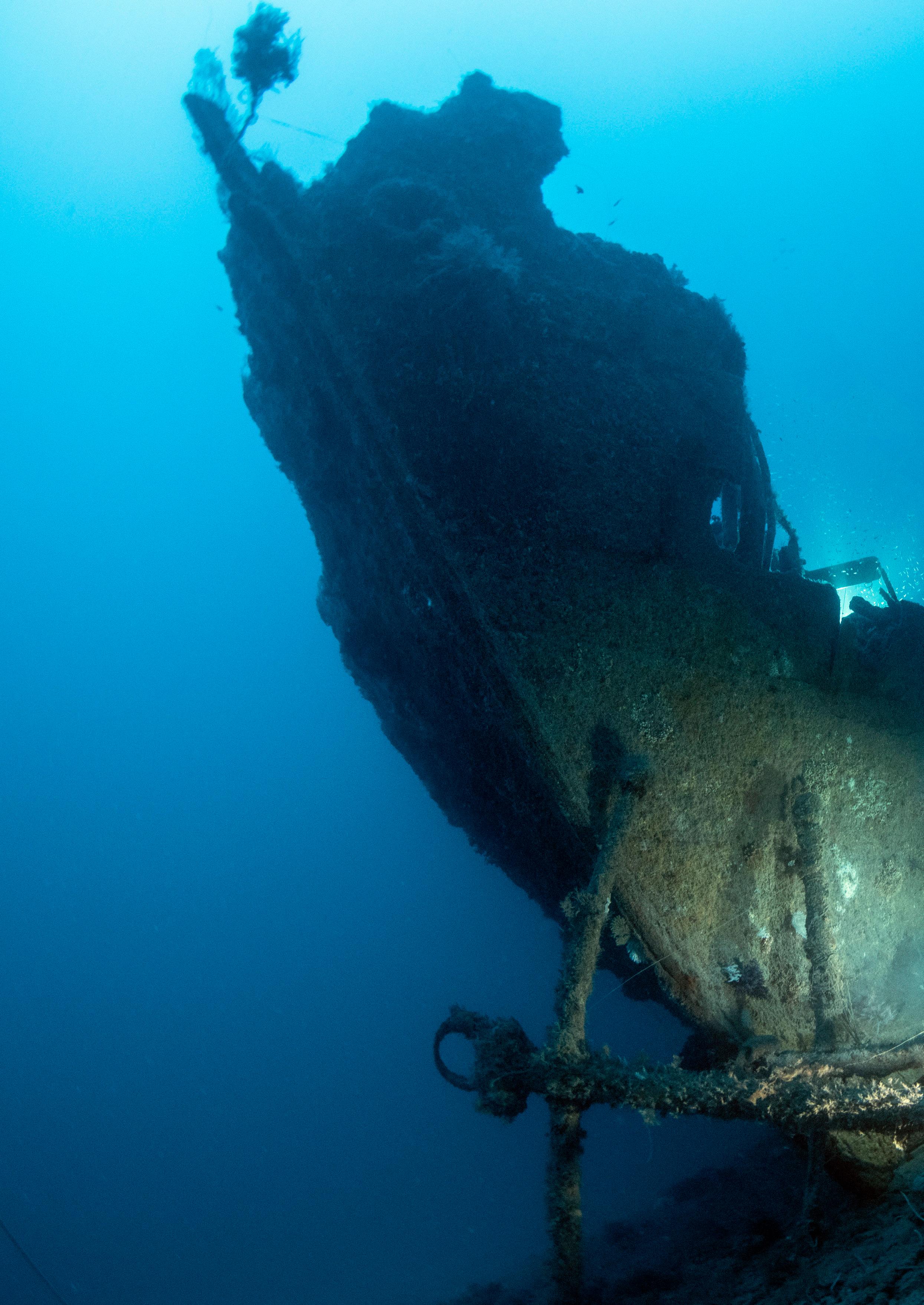
11 minute read
Mystery Steamship – New Shipwreck in the Red Sea
FEATURE AND PHOTOGRAPHY JESPER KJØLLER
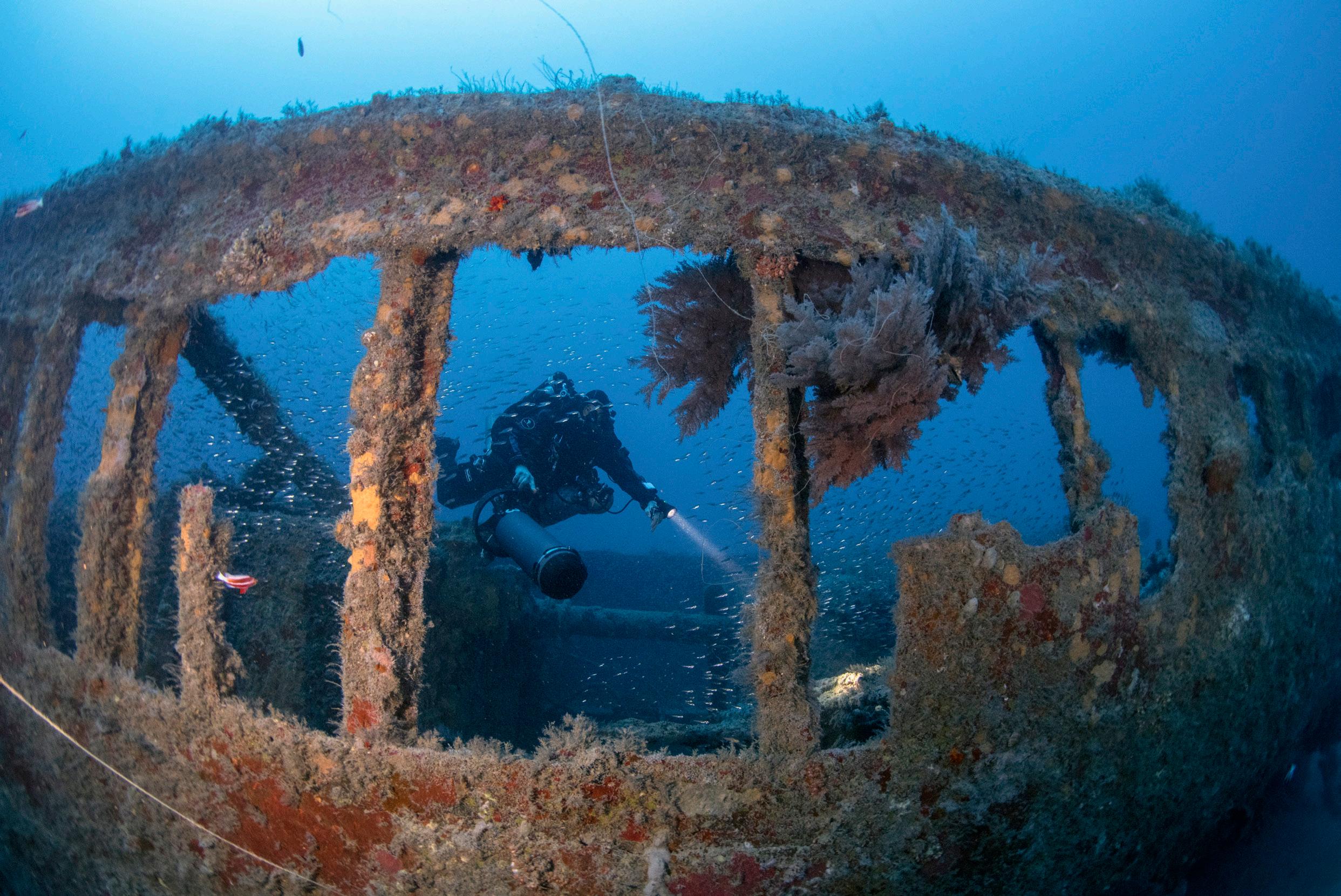
Some of the plating on the port side is gone revealing the ribs of the hull.
Advertisement
A few years ago, using a combination of advanced diving technologies and trusty old wreck finding methods, I was part of a dive team for the Red Sea Explorers that successfully discovered a virgin shipwreck in the Strait of Gubal. It would take another two years before conditions allowed us to go back to shoot good images from the 80-metre-deep wreck believed to be the Brazilian corvette, SC Almirante Barroso.
Wow! I can’t believe our luck. We anticipated a ripping current, but the thick rope that was dropped by the crew on our mothership M/V Nouran is falling straight down into the unusually clear water. Did we really break the code and figure out how to time the dive in relation to the tidal charts and weather forecasts? Filled with anticipation, I let myself fall through the water column a few metres away from the rope, and for a moment I even contemplate preparing my camera and unfold the strobe arms in the tranquil environment on the way down. But then, at around 50 metres, I notice that the rope begins to shiver and shake. I look down and discover a sharp bend on the rope below me, indicating that the current is picking up further down. I realise that I’ve drifted too far away from the rope now, so I keep the scooter at full speed and I fin as hard as I can. I tuck my head in-between my arms to make me more streamlined, but I’m not moving any closer, and the current is really powerful now. I remind myself to be careful not to overexert myself to avoid carbon dioxide build-up – hypercapnia is the rebreather diver’s number one enemy. Now I can see the contours of the wreck below me. I realise that down on the seafloor,the hull ofthe wreckage will create a shelter from the current.
My buddy Daniel is smarter than me and has been holding on to the rope during the entire descent. Also, he does not have the added drag of my big camera. I am confident that he is in control and that he will continue his descent along the rope, so I decide to scooter straight down towards the ocean floor at 80 metres ratherthan fight against the unforgiving current. As soon as I am sheltered behind the wreck, I can quickly make my way to the ship with the scooter at full speed along the ocean floor to reunite with Daniel. We arrive at the wreck at the same time but through different means. Lesson learned: Do not let go of the rope!
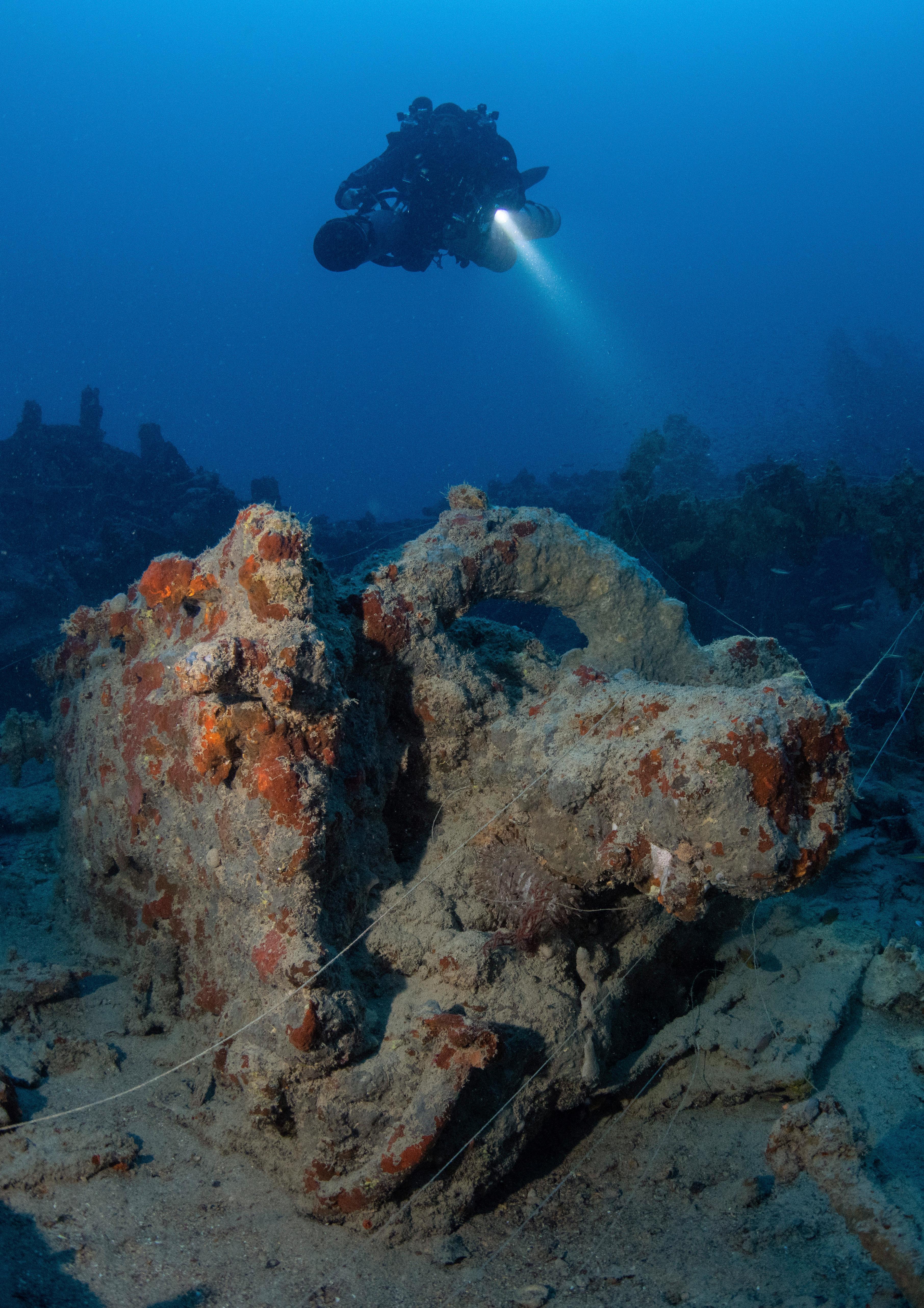
Daniel Schelvis posing above a winch of some sort.
SMOKING GUN
The downline from our mothership, MV Nouran is situated just a few metres in front of the bow of the wreck, where the two large anchors are lying. It’s a perfect drop! Daniel immediately positions the video lights to illuminate the bow and the anchors, and he assumes a good position for modelling. We have had a couple of days to practice the technique and communication on easy wreck dives in the region (Abu Nuhas and Thistlegorm), so we can work fast and efficiently. The visibility is excellent and the ambient light is good even if we are deep, and it is only around 10 am. The current is a small price to pay for clear water.
After the shots at the bow, we venture inside the open hull to explore and shoot more images. The other half of our four-person dive team, prominent Italian GUE instructors and wreck explorers Mario Arena and Stefano Gualtieri, are already immersed in looking for clues that can support a 100 percent positive identification. We believe that the wreck is the Brazilian steam-powered sailing corvette Almirante Barroso, but we still need the smoking gun to prove it.
Mario Arena, being one of the most experienced wreck explorers on the planet, knows where to look and he is searching for clues. A boilerplate with the name, a serial number on an engine part, or a ship’s bell would be the typical things to look for. But Mario draws a blank and is not able to find anything conclusive.
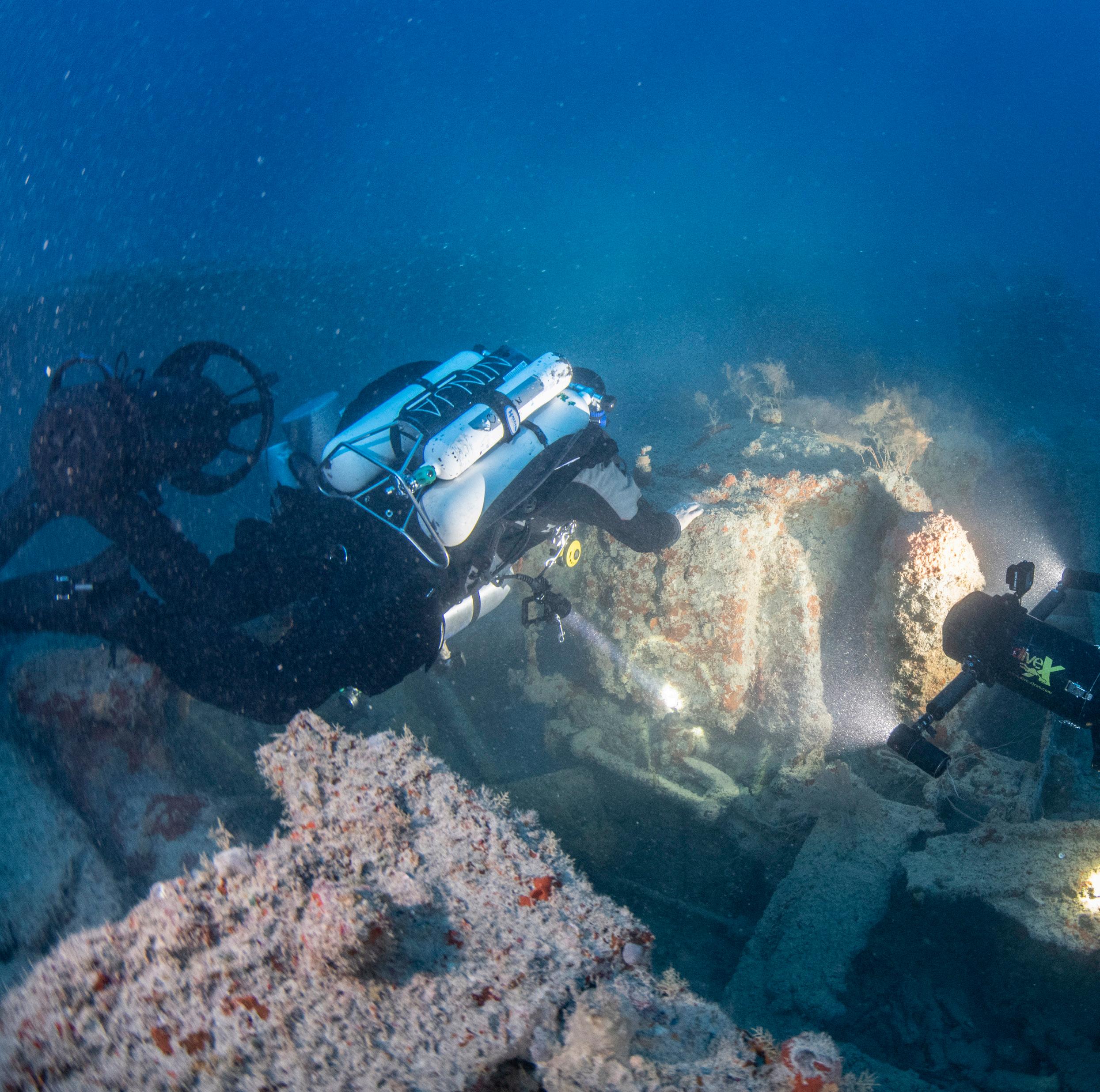
The Italians looking for clues around the engine.
OCCAM'S RAZOR
Scientists often refer to a problem-solving principle called Occam's Razor when trying to figure out complex problems.This principle suggests that the simplest solution to a problem is most likely the right one. Occam’s Razor declares that when presented with competing hypotheses, one should select the one that is based on the fewest assumptions.
The Almirante Barroso went down in 1893, and we have found a wreck that looks like her from that period. If it is not the Almirante, there must be another similar ship missing, and at the same time, the Almirante must lie somewhere else in the vicinity. Occam’s Razor suggests that we have found the Almirante Barroso. But we still need to prove it…
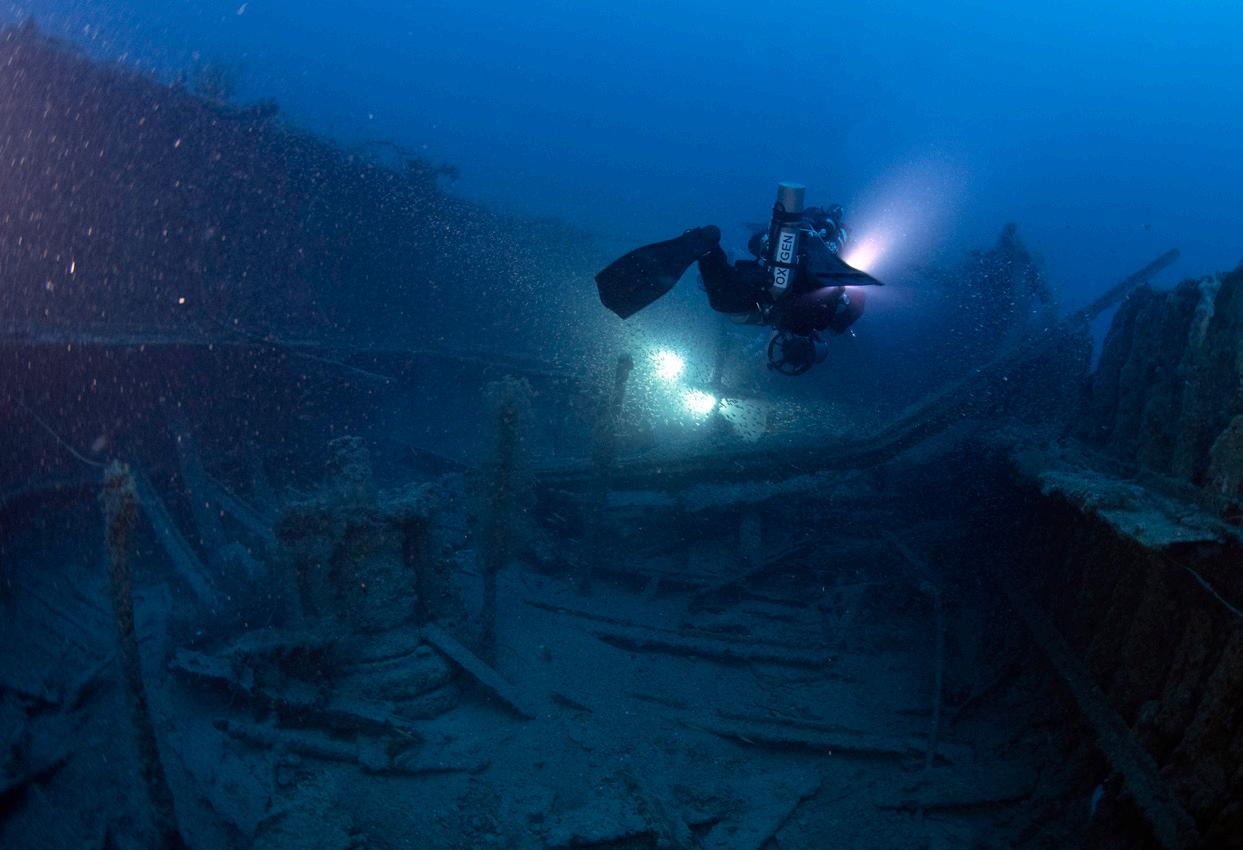
What cargo the ship carried is still unknow.The holds seem empty.
I ask Faisal Khalaf from Red Sea Explorers about the identification process. –none of the items found on the wreck thus far provide 100% identification.However,the size,location, and different characteristics of the wreck make us quite confident ofits identity, Faisal says.
For example, there is damage to the hull where the rigging used to connect. Items such as pulleys and blocks used in sailing rigs which are further evidence that she is a tall ship. The question as to where the superstructure has gone is answered by the fact that this is a sailing ship with limited or no superstructure. The missing parts were likely made of wood that has since disintegrated.
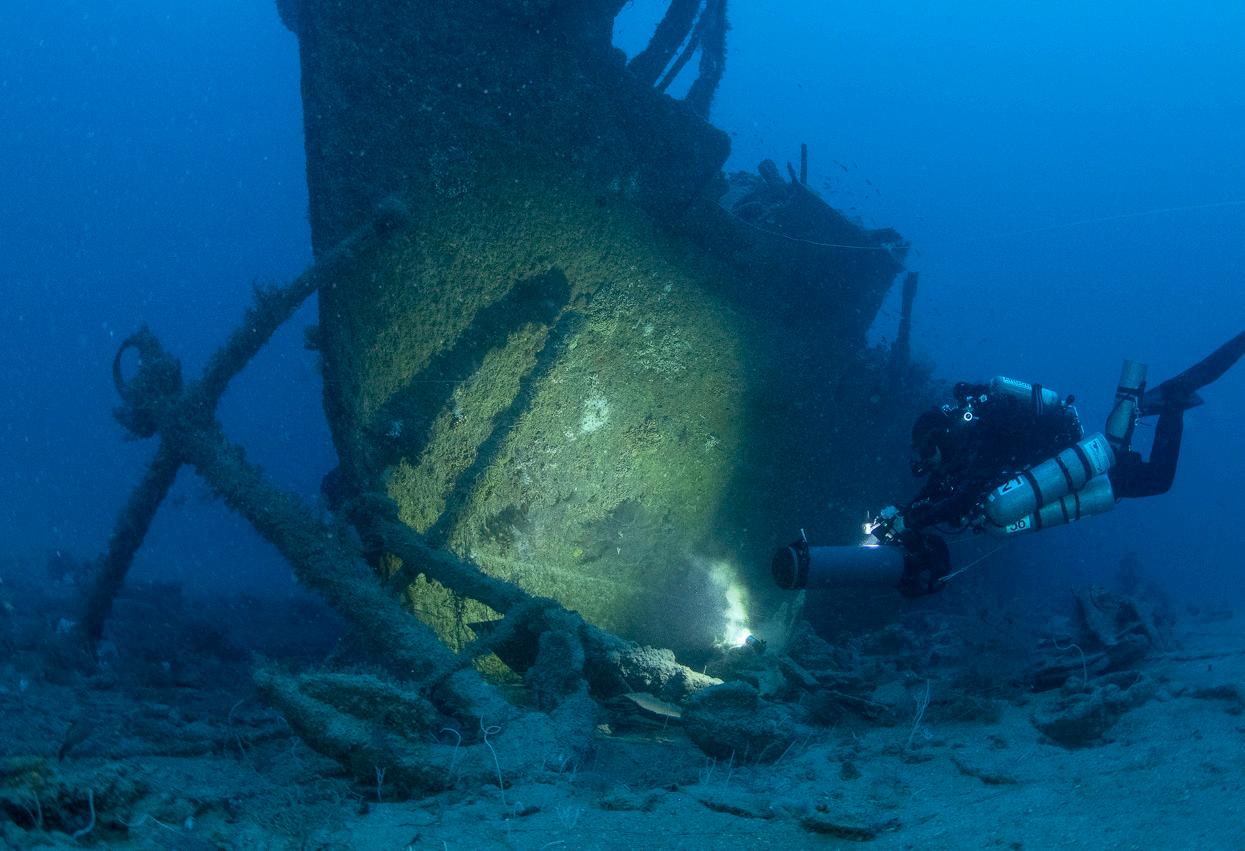
The two anchors in front of the impressive stern section.
Faisal explains that our mission now is to continue to document and catalogue all the parts of the wreck for further research. Using different technologies, such as photogrammetry and video documentation, we aim to keep a thorough record of what was discovered. We will also search for items that might be buried in and around the wreck. This is a long-term project, and lots of dives will be conducted on the wreck as part of the Wreck Exploration Project.
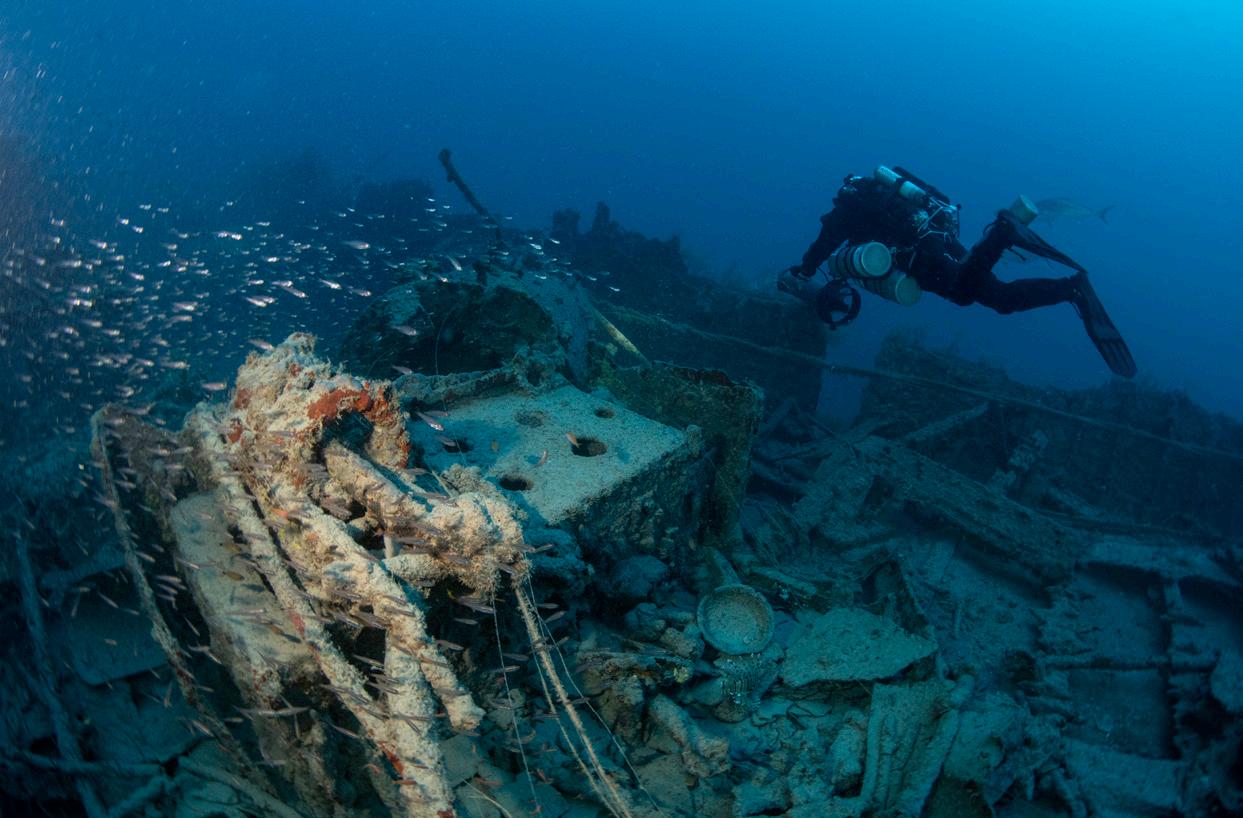
The massive oven and stove where the galley was before the decks collapsed.
OLD AND NEW METHODS
Without a doubt, the Egyptian Red Sea is one of the planet’s most dived oceans. You would think by now that all its secrets have been revealed and that all areas are fully explored. On the other hand, the Red Sea is one of the busiest sailing passages in the world, so it is no wonder that a lot of ships have ended up on the bottom of the Strait of Gubal since the inauguration of the Suez Canal in 1869. However, most of the lost vessels lie at depths outside the range of recreational diving, and it takes a lot of dedication and effort to locate them. Finding new wrecks in the Red Sea is, therefore, a rare occurrence.
Nowadays, most new wrecks are found with modern technology, but Egyptian law prohibits the use of side-scan sonars. So Faisal Khalaf reverted to old, trusty methods and teamed up with a local fisherman, Hamdi. He had a small handheld GPS with hundreds of promising positions where his colleagues had lost trawls or noticed resistance when pulling in their nets. The fishermen were promised 2,000 Euros for every position that turned out to be a virgin wreck, and so far, half a dozen new wrecks have been located.
The fishermen have an impressive knowledge of the positions and can describe details of the wrecks purely based on the pieces of debris pulled up by their angling tools.
The wrecks are found using old methods, but they are dived with new technology. When diving in deep water surrounded by huge container ships in a busy sailing lane, it is essential to use the safest and most reliable gear. We use trimix-based CCRs and powerful underwater scooters – two technologies that have recently reached a level of maturity, and make it possible to do safe exploration of areas that were inaccessible 10-15 years ago.
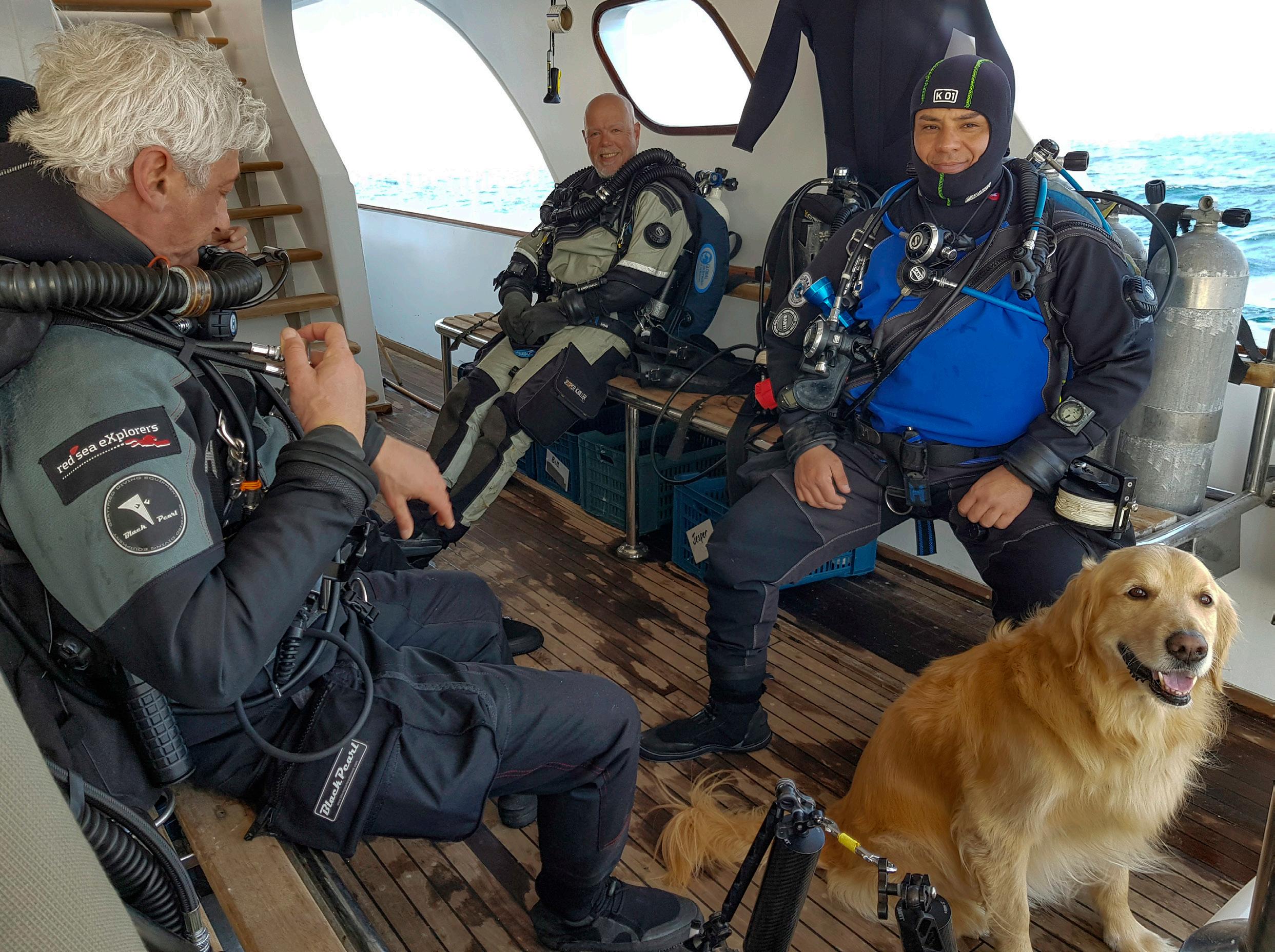
Getting ready and being observed by Red Sea Explorers’ mascot,Antar the dog.
HAVE PICTURES OR IT DIDN’T HAPPEN
I’m thinking back on our inaugural dive on the wreck in February 2018.The first attempt to reach the wreck was aborted – the current at the bottom made it impossible. After 20 minutes scootering at full throttle against a ripping current, while following a horizontal line of 65 metres, we had to give up. I was desperately holding on to the line with my left hand and operated the scooter with the right. We were moving slowly but with great effort, and it became clear that it was not sustainable, so the dive was aborted. We never reached the wreck, but the sonar image on the bridge of the MV Nouran was so tempting and alluring that it was decided to make another attempt later the same day, hoping that the current would have lessened, and conditions improved. We still did not know what lay waiting for us. A wreck? A lost container? A hull-shaped reef? Or maybe just MS Sand – the largest wreck in the world.
Imagine the thrill we experienced when we reached the bottom at almost 80 metres and discovered that the shot line was just a few metres away from a structure that turned out to be the wreck of a large steamship. Unfortunately, the visibility was terrible, and because of the difficulties we experienced on the first attempt, I had left my big camera system back on the surface. We only had a scooter-mounted GoPro to document the dive, and you can clearly hear our joyful screams on the video.
The marine life on the wreck was spectacular. There was very little protection against the strong current on the sandy bottom around the site, so the wreck offers a shelter that makes the marine life thrive. The hull was filled with glassfish chaperoned by enormous groupers and lionfish. Giant trevallies were roaming the area, and they were even visible on the sonar. No wonder the area is an attractive fishing ground!
We were ecstatic with our new discovery, but we only had sparse GoPro-documentation, so we wanted to go back. It would take two years until I had a chance to dive the Almirante again. In the meantime, a few other dives were made, and a handful of artefacts were recovered.
MYSTERY WRECK
Lots of questions need to be answered. Where are the cannons? What was the cargo, and where is it? Maybe the ship was turned upside down before landing upright on the seafloor and everything spilled out? What reef did it hit, and is there a debris field leading to it? And the most essential discovery still remains: the irrevocable proof that the mystery wreck is, in fact, the Almirante Barroso.
All these questions will be answered during the ongoing wreck exploration weeks that are planned each year.
DIVE TEAMS
2018 TEAM The international explorer’s team consisted of Faisal Khalaf (Lebanon), Jesper Kjøller (Denmark), Sameh Sokar (Egypt), Igor Siryk (Ukraine), and Michel Salsmans (Belgium).
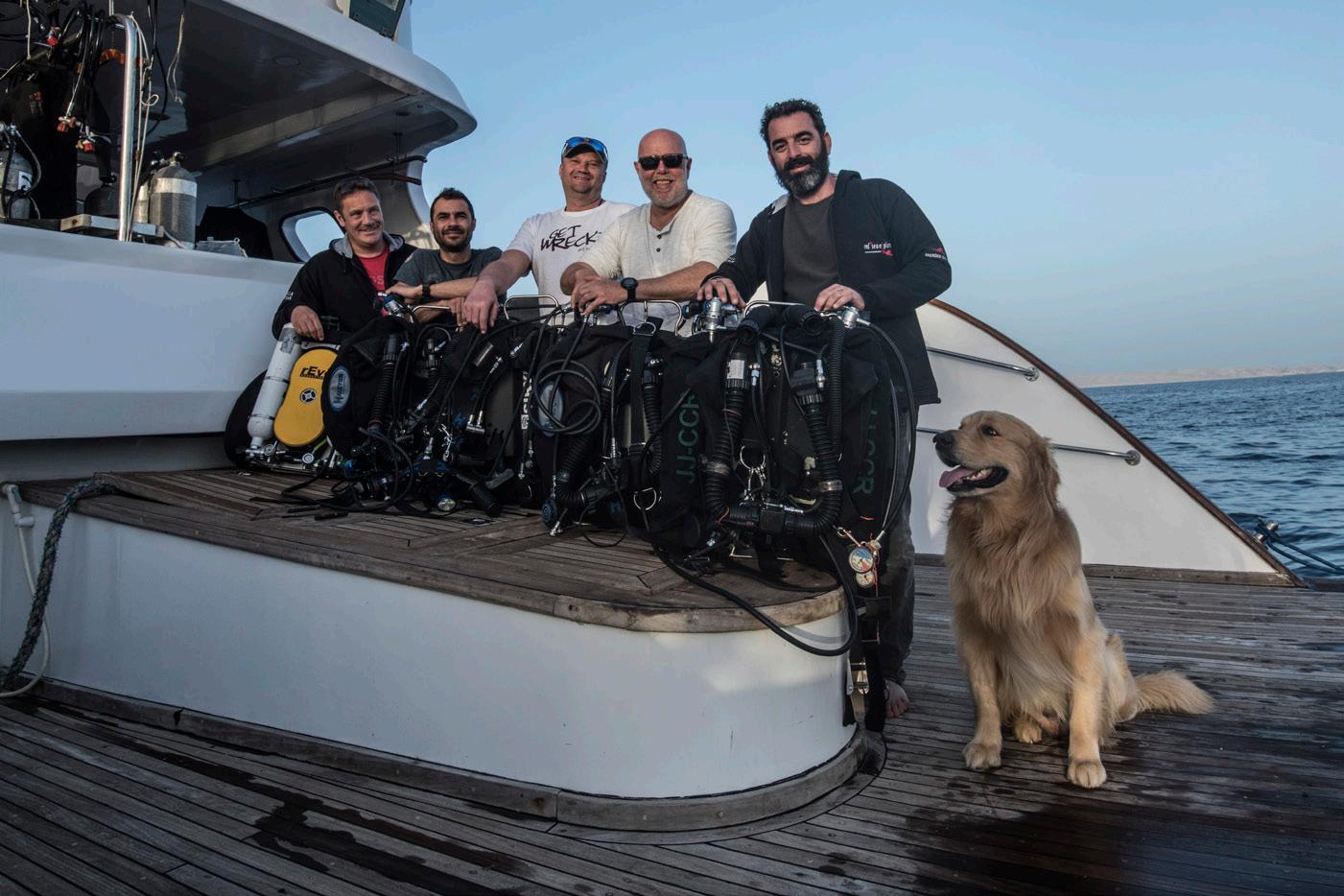
2018 team.
2020 TEAM Mario Arena, Stefano Gualtieri (Italy), Daniel Schelvis (Spain) and Jesper Kjøller (Denmark).
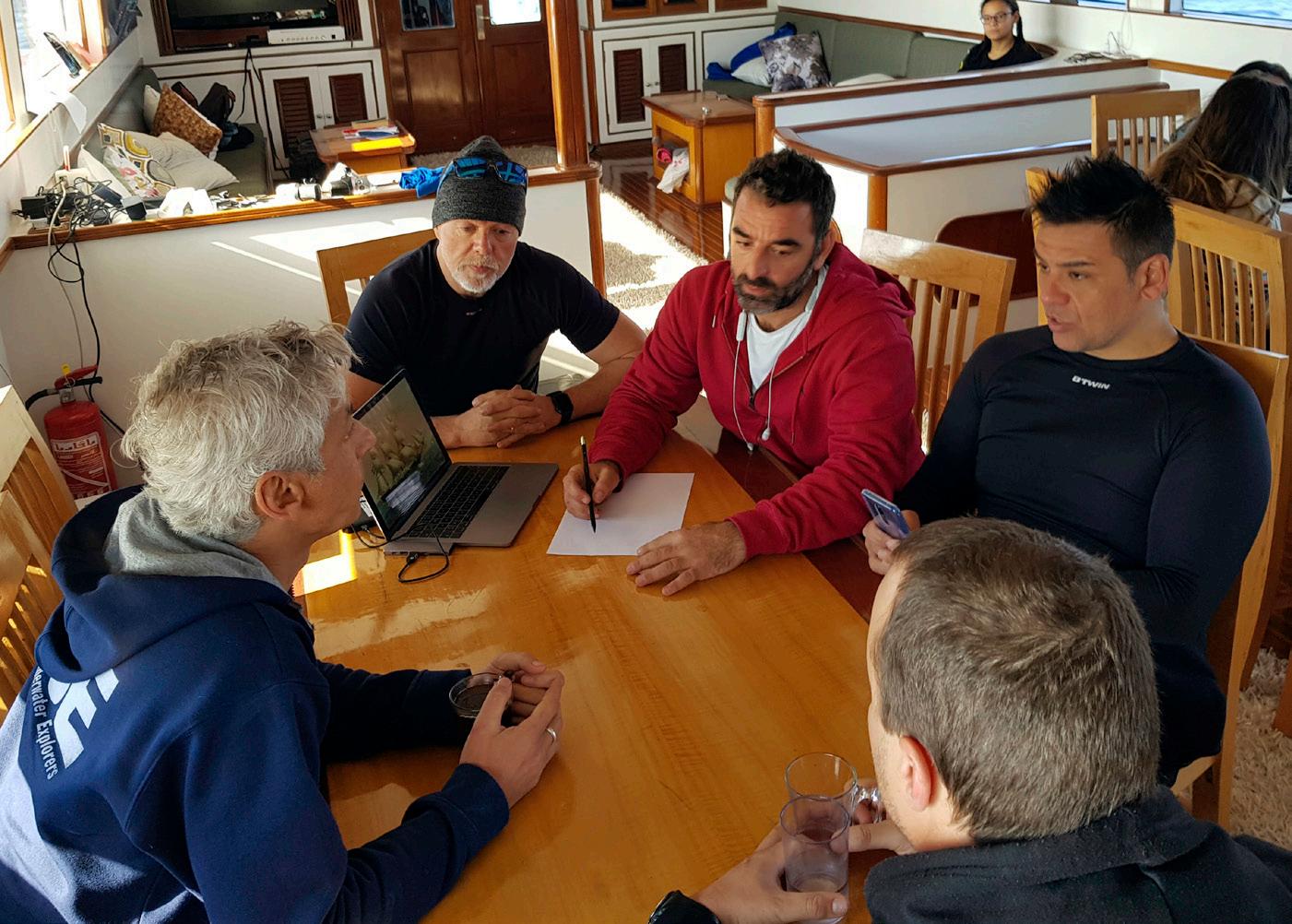
2020 team.
FACT FILE
ALMIRANTE BARROSO The Barroso was built at the Navy Yard in Rio de Janeiro. It was launched on April 17, 1882, under the presence of emperor Dom Pedro II and admiral Francisco Manuel Barroso da Silva. The Almirante Barroso was the second ship in the Brazilian Navy to be named after the war hero Admiral Barroso (September 29, 1804 - August 8, 1882). Later, several other ships would share the name. She was wrecked when she collided with a reef near Ras Zeith in the Northern Red Sea during a circumnavigation voyage. An English gunboat rescued the castaways.
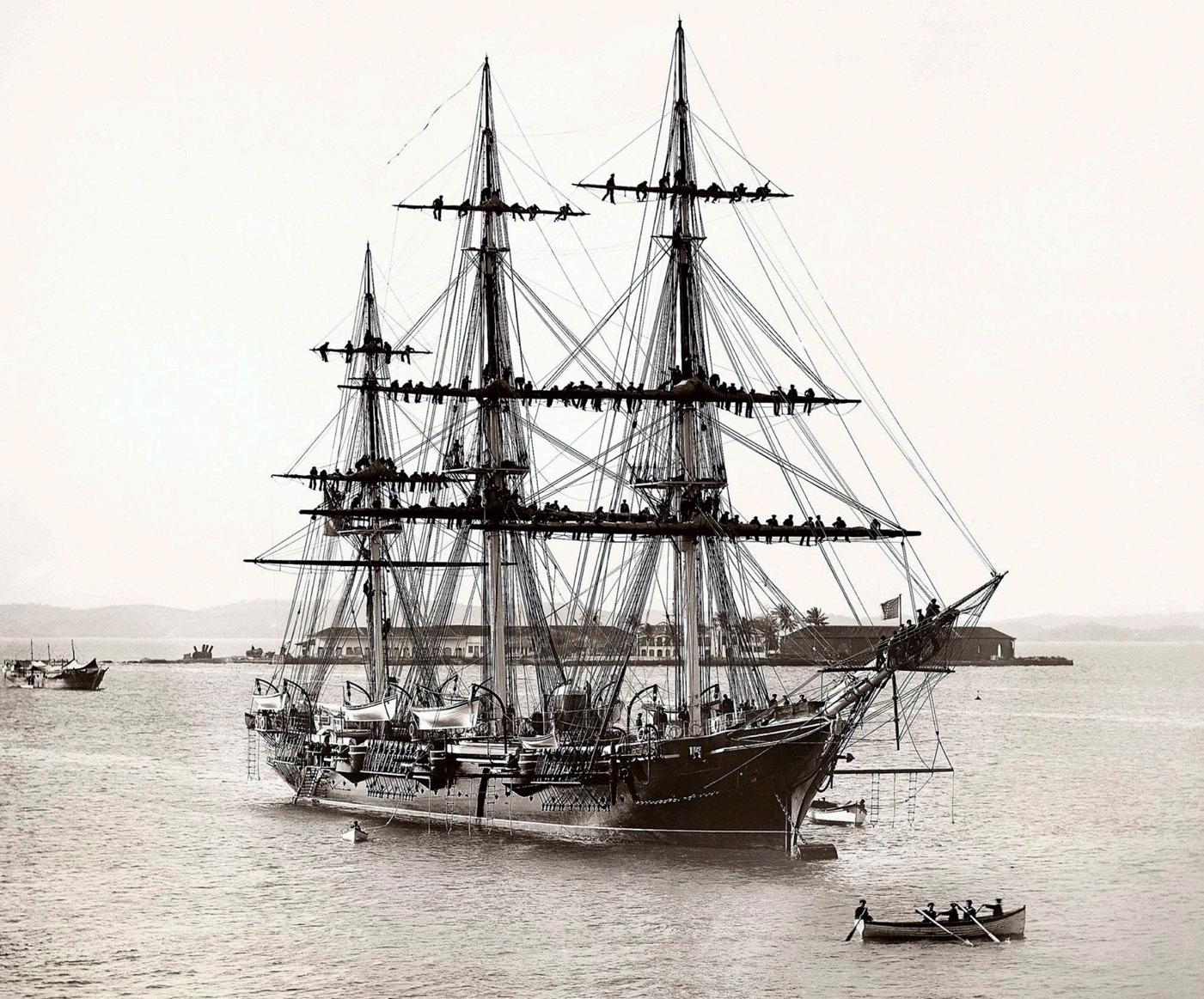
Almirante Barroso served as a training vessel for the Brazilian Navy.
LAUNCHED: 17 April 1882 MATERIAL: Wood and steel DISPLACEMENT 2.050 tons DIMENSIONS:
Length: 71.25 m Beam: 11.33 m
Draft: 5.10 m PROPULSION: Mixed sail and steam
Steam Engine: 2.170 HP
Sail Surface: 1.625 m² CREW: Unknown SPEED: 12 knots LOST: 21 May 1893
DIVING THE ALMIRANTE
EQUIPMENT JJ-CCR in GUE Configuration, Suex Scooters
BACK GAS 12/65 BAILOUT 12/65, 50% and 100%
LOCATION Nor th of Gubal Island, west of the TSS (Traffic Separation Scheme) at the mouth of the Gulf of Suez.
TOPOGRAPHY The wreck is sitting in a flat sandy area.
DIVE CONDITIONS Advanced hypoxic trimix dive with lots of currents, both at the surface and on the wreck. Windy surface conditions make it tricky on the surface, and the proximity to a busy sailing lane makes it paramount to ascent on the line.
FACT FILE
THE RED SEA EXPLORERS WRECK EXPLORATION PROJECT
As the name implies, Red Sea Explorers are dedicated to exploring and protecting the wonders of the Red Sea and have been doing so during the last 15 years as one of Egypt’s most popular and successful liveaboard dive operations.
The Wreck Exploration Project is an ongoing project that dedicates a couple of weeks each year to finding and exploring new shipwrecks.
Even if you are not able to do long and demanding decompression dives at great depths, you can still participate in the Exploration Projects as a support diver. That is a great way to learn more about technical diving projects and gain experience as a project diver.
www.redseaexplorers.com










